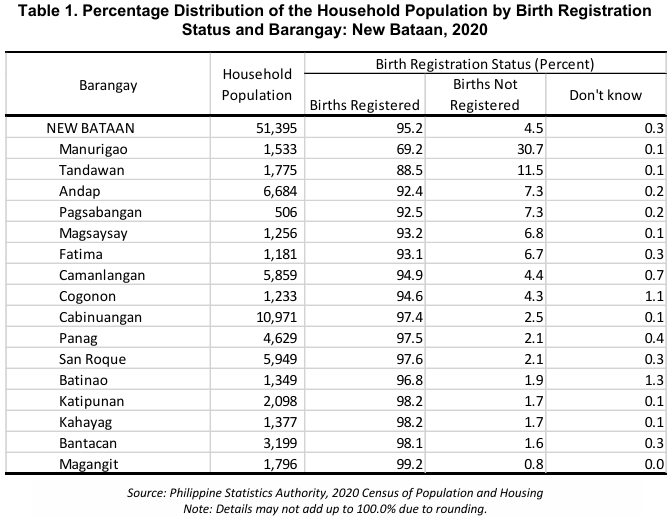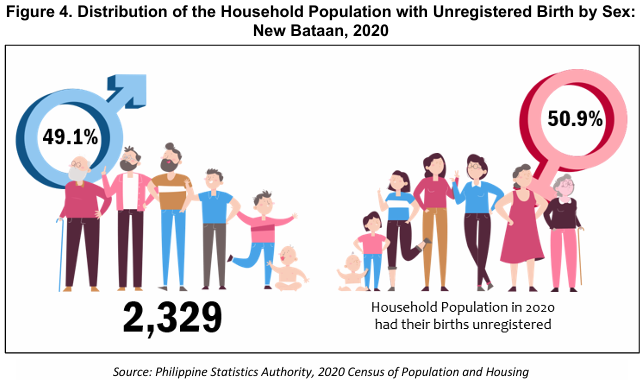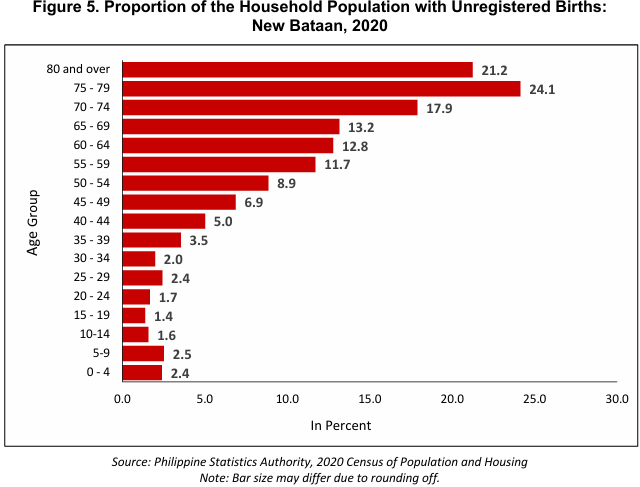Proportion of persons with unregistered births in New Bataan decreases to 4.5 percent
The 2020 Census of Population and Housing (2020 CPH) revealed that a total of 2,329 persons of the household population in 2020 had their births unregistered with the Local Civil Registry Office (LCRO) of New Bataan. This is equivalent to 4.5 percent of the 51,395 household population in 2020. (Figure 1)
Moreover, census results from 2015 to 2020 show a decreasing trend in the proportion of persons with unregistered births, from 5.4 percent to 4.5 percent in 2020. The 2020 figure is lower by 0.9 percentage point. (Figure 1)

New Bataan is 3rd highest in the proportion of persons with unregistered births
In 2020, Davao de Oro reported a 3.6 percent of the household population whose births were unregistered with the LCROs. At the municipal level, Monkayo posted the highest with 5.5 and followed by Mabini with 4.9 percent. Meanwhile, New Bataan recorded a proportion of 4.5 percent and ranked 3rd highest in the province with the highest proportion of persons with unregistered births. (Figure 2)
Two other municipalities posted a proportion higher than the provincial level, namely, Laak and Mawab. (Figure 2)

On the other hand, Nabunturan posted the lowest proportion of persons with unregistered births (2.4%), followed by Pantukan (2.6%), Montevista (2.8%), and Maco (3.0%). (Figure 2)
Proportion of persons with unregistered births is highest in Manurigao; lowest in Magangit
Among the 16 barangays, Manurigao posted the highest proportion of the household population whose births were reported to be unregistered at 30.7 percent, corresponding to 471 persons out of the 1,533 household population in the barangay. It was followed by Tandawan with 11.5 percent (204 persons), and Andap and Pagsabangan both with 7.3 percent. (Table 1 and Figure 3)

Meanwhile, Magangit recorded the lowest proportion of unregistered births at 0.8 percent, followed by Bantacan (1.6%), and Kahayag and Katipunan (both at 1.7%). (Table 1 and Figure 3)

More females than males have unregistered births
Among the 2,329 household population whose births were unregistered with the LCRO, 49.1 percent (1,144) were males, while 50.9 percent (1,185) were females.

This translates to a sex ratio of 97 males whose births were unregistered with the LCRO for every 100 females whose births were also unregistered. (Figure 4)
At the barangay level, Manurigao which had the highest proportion whose births were unregistered with the LCRO, on the other hand, showed a higher percentage of males at 50.1 percent compared to females which had 49.9 percent.
The 75-79 years age group posts the highest proportion of unregistered births
Across age groups, the household population aged 75-79 years had the highest proportion of unregistered births at 24.1 percent. The high proportion was also noted in the age group 80 years old and above (21.2%), followed by those in the age groups 70-74 years (17.9%), 65-69 years (13.2%), and 60-64 years (12.8%).

In contrast, the lowest proportion was recorded in the age group 15-19 years at 1.4 percent (Figure 5)
In addition, 15.8 percent or 756 persons out of 4,773 aged 60 years and above were reported in the census to have unregistered births. This means that about 16 in 100 senior citizens have unregistered births. (Figure 5)
Manurigao posts the highest proportion of persons who never had a copy of their birth certificates
While 4.5 percent of the household population revealed that their births were unregistered, about 9.2 percent reported that they never had a copy of their birth certificates. A total of 4,733 persons of the 51,395 household population were reported to never had a copy of their birth certificates. (Table 2 and Figure 6)

Among the 16 barangays, Manurigao recorded the highest proportion of household population who never had a copy of their birth certificates, 39.1 percent or 599 persons. It was followed by Tandawan (12.9%), Andap (12.7%), and Camanlangan and Pagsabangan (both at 12.5%). (Table 2 and Figure 6)
Magangit posted the lowest proportion of persons who never had a copy of their birth certificates at 3.8 percent, followed by Cabinuangan (Poblacion) at 4.6 percent, and Batinao at 5.1 percent. (Table 2 and Figure 6)

TECHNICAL NOTES
The statistics presented in this Special Release were based on the answers and information provided by the respondent or any responsible member of the household to the questions on birth registration about all the household members. For the 2020 CPH, birth registration data of all household members were collected by asking the respondents, “Was ______’s birth registered with the Local Civil Registry Office?” and “Has _____ ever had a copy of his/her birth certificate?”
